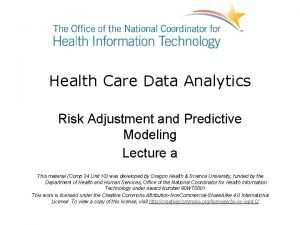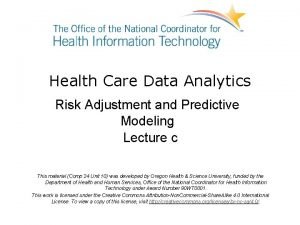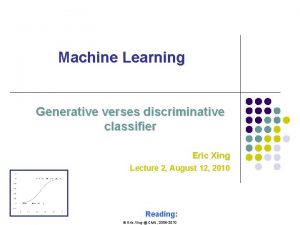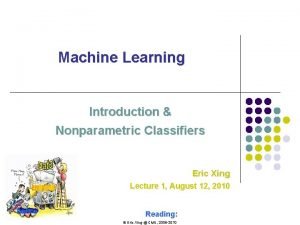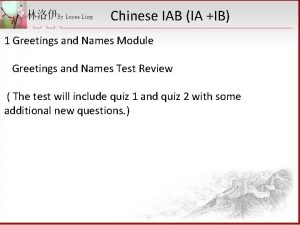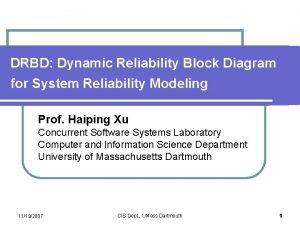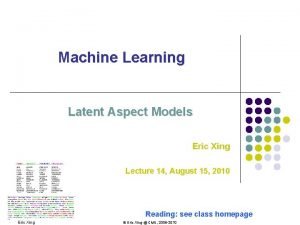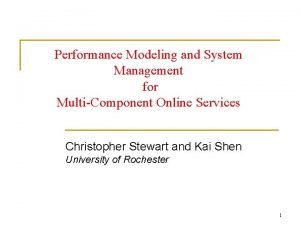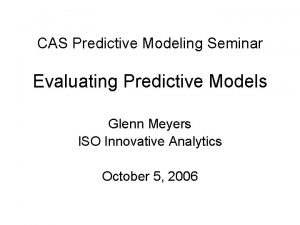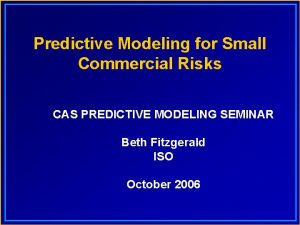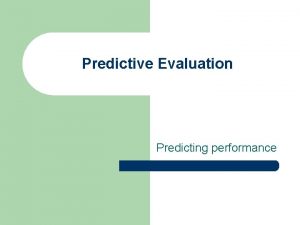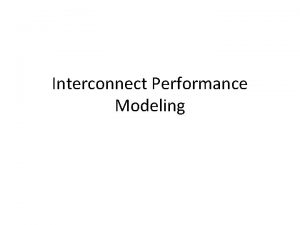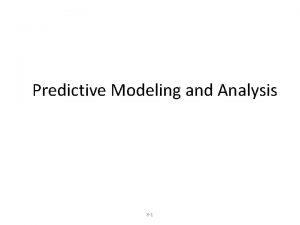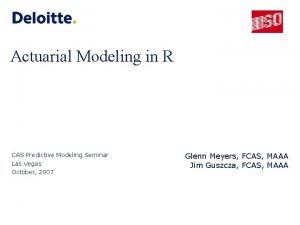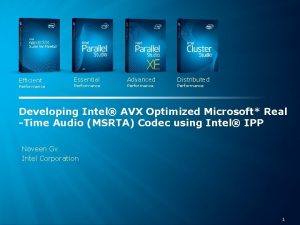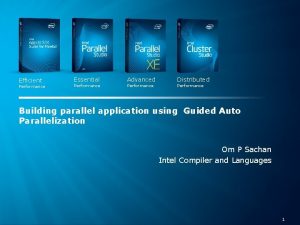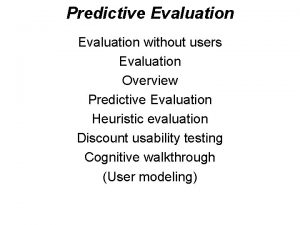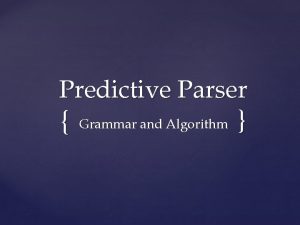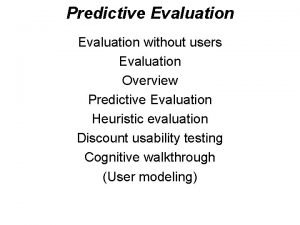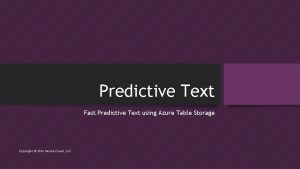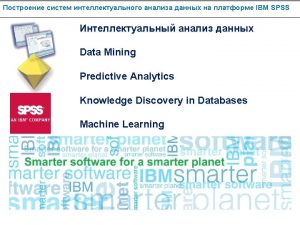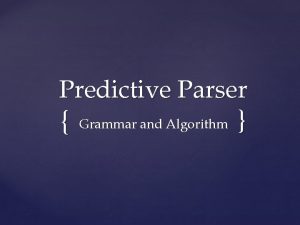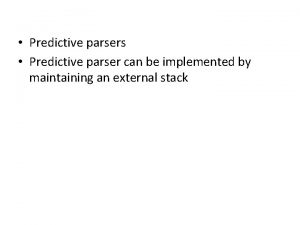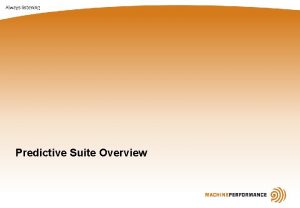Predictive Performance Zhi Xing On Predictive Modeling for
























- Slides: 24

Predictive Performance Zhi Xing

On Predictive Modeling for Optimizing Transaction Execution in Parallel OLTP Systems

Introduction • Goal: optimize transaction throughput based on predictions • Online Transaction Processing (OLTP) workloads: short-lived, repetitive, highly concurrent, access small subset of data • Share-nothing parallel database

Introduction • Stored procedure-based transactions: effective for OLTP applications (reduce round-trips)

Transaction Optimizations • OP 1 - Execute the transaction at the node with the partition that it will access the most • OP 2 - Lock only the partitions that the transaction accesses • OP 3 - Disable undo logging for non-aborting transactions • OP 4 - Speculatively commit the transaction at partitions that it no longer needs to access

Transaction Models • Markov models • Generated from transaction histories (workload trace) - procedure input parameters - queries - query parameters • One model for each procedure


Model Generation • Construction phase - start with begin, abort, commit - add vertices and edges while going through each transaction • Processing phase - traverse bottom-up to calculate probabilities

Predictive Framework

Parameter Mapping • Observation: query parameters for table partitioning attributes are often provided as procedure input parameters • For each pair of procedure parameter and query parameter - count the number of times they have the same value - mapping coefficient = count / number of comparisons

Initial Estimate of Execution Path • A state is valid if - partition to be accessed can be determined from the mapping - next state has the correct previous accessed partitions • Go to the valid state with the highest probability • Repeats until either abort or commit is reached

Optimizations • Initially based on initial estimate of execution path • Updated according to actual execution path • Confidence coefficients are calculated by aggregating the probabilities on the vertices

Model Partitioning • Limitation: too many useless states and transitions • Improvement: - cluster transactions - find the best clustering

Experiments

Performance and Resource Modeling in Highly. Concurrent OLTP Workloads

Introduction • Goal: predict resource usage for concurrent workloads • Existing tools fail to model performance problems resulting from interactions between concurrent queries • OLTP workloads: high concurrency, complex interactions between transactions • DBSeer: produces models that accurately predict resource usage such as disk I/O, RAM, and locks (for My. SQL)

Overview

Preprocessing • Gather regular logs and statistics from - SQL query - DBMS (My. SQL) - OS (Linux) • Transaction clustering - Extract transaction summaries (time, type of lock, accessed table, number of rows accessed) - Learn transaction types using unsupervised clustering • Estimate access distributions - Extract exact pages accessed from SQL logs - Calculate probability distribution of page by access (read/write) and by transaction type

Modeling Disk I/O and RAM • Log writes - proportional to the rate of each transaction type in the load (linear regression) • Log-triggered data flushes - log is full and needs to be rotated or recycled • Capacity misses - buffer pool is full

Capacity Misses • Create a list of N elements to represent buffer pool (Assuming RAM has N pages) • Derive access distribution for all the disk pages according to the transaction mixture • Randomly select pages according to the distribution • Simulate LRU cache policy, record the number of disk reads and writes • Calculate reads and writes per transaction per second

Experiments

Some Other Researches

• Towards Predicting Query Execution Time for Concurrent and Dynamic Database Workloads - predicting the execution time of a single query in a concurrent and dynamic setting • Uncertainty Aware Query Execution Time Prediction - add indication of uncertainty to the last paper - give predictions like “with probability 70%, the running time of this query should be between 10 s and 20 s” • Automated Analysis of Multithreaded Programs for Performance Modeling - predict performance for multithreaded programs such as DBMS (with different configurations)

Q&A
 En dian zhi lu
En dian zhi lu Yi zhi zou
Yi zhi zou Aep predictive modeling
Aep predictive modeling Predictive risk modeling
Predictive risk modeling Health care risk adjustment and predictive modeling
Health care risk adjustment and predictive modeling Health care risk adjustment and predictive modeling
Health care risk adjustment and predictive modeling Helen erickson nursing theory
Helen erickson nursing theory Relational modeling vs dimensional modeling
Relational modeling vs dimensional modeling Eric p. xing
Eric p. xing Sang xing tang
Sang xing tang Eric xing
Eric xing Eric xing
Eric xing Qing wen nin gui xing
Qing wen nin gui xing Nǐ guì xìng
Nǐ guì xìng Eric xing
Eric xing Salitang teknikal halimbawa at kahulugan
Salitang teknikal halimbawa at kahulugan Pid xing
Pid xing Spectral clustering
Spectral clustering Liudong xing
Liudong xing Nǐ xìng shénme
Nǐ xìng shénme Eric xing
Eric xing Eric xing cmu
Eric xing cmu Performance modeling
Performance modeling Sju för caesar
Sju för caesar Boverket ka
Boverket ka




